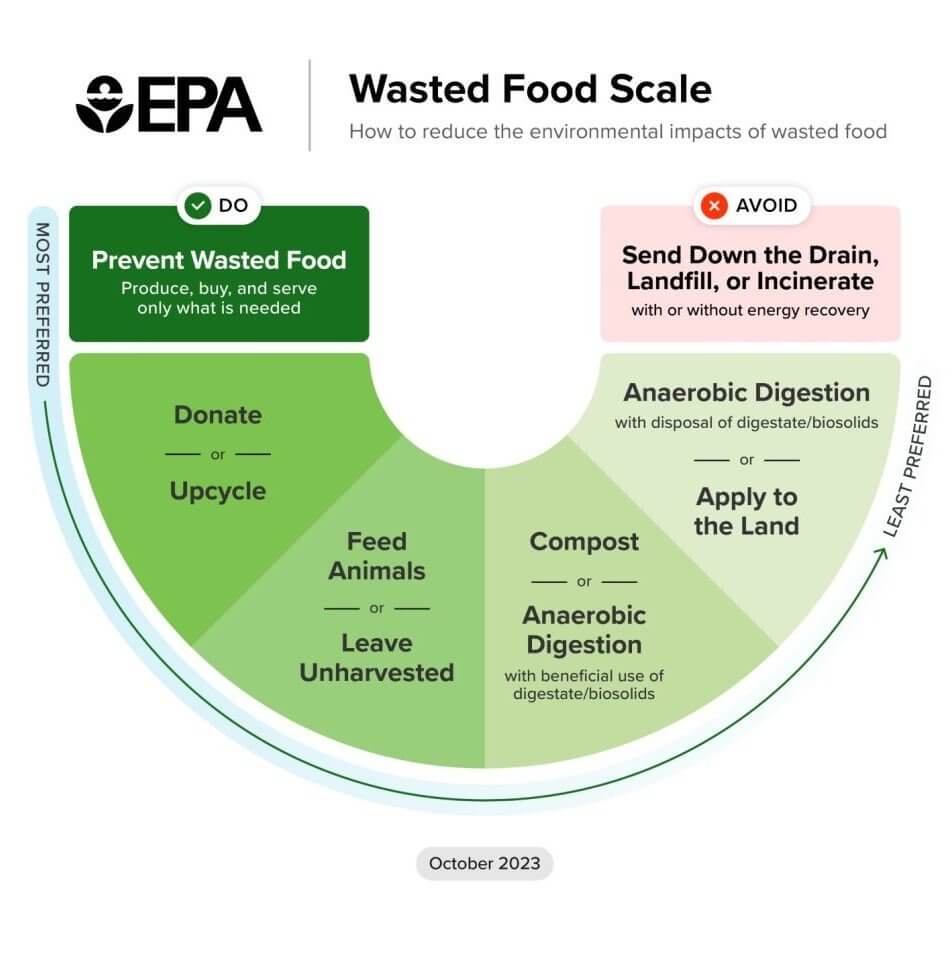Unwrapping EPA’s New Wasted Food Scale
Unwrapping EPA’s New Wasted Food Scale

For decades, EPA’s Food Recovery Hierarchy has served as the primary tool to help decision makers (i.e., state and local governments) understand and determine the best options for managing food waste (Environmental Protection Agency, 2023). The hierarchy was established in 1990, so needless to say, an updated version has been eagerly anticipated. The way the former hierarchy was laid out, compost was listed just one level above incineration and landfilling. It was my belief that composting needed to be analyzed more thoroughly and moved up the scale to a more preferred spot on the hierarchy because of the potential for compost use to sequester carbon, improve water and soil quality, while reducing erosion and increasing water retention.
Food Waste Scale Unwrapped

I have been hoping for years that EPA’s Food Recovery Hierarchy would be retired for a new model that takes into account the types of food waste when assigning preferred strategies to manage it. I was super excited to see that on October 19, 2023, the US Environmental Protection Agency (EPA) released the Wasted Food Scale, a new graphic that details strategies to manage food waste, which are ranked from most preferred to least preferred with the addition of five new strategies:
- Prevention
- As it should be, the most preferred method to manage food waste is to not generate it in the first place.
- Donate or Upcycle - NEW
- Upcycle - this highly recommended strategy uses less desirable scraps of food (such as lemon and banana peels) and turns them into new edible food products.
- Feed Animals or Leave Unharvested - NEW
- Leave unharvested - this strategy is utilized for various reasons, such as when there are labor shortages, no buyer for the food, crop disease, flooding, drought or damage from pests and insects. Leaving food unharvested prevents the environmental impacts of harvesting, packaging, and transporting the food while promoting grazing and better soil health.
- Anaerobic Digestion with Beneficial Use of Digestate and Biosolids - NEW
- This level of the Wasted Food Scale generates renewable energy, but also takes into account the use of by-products as fertilizers or soil amendments that decrease reliance on traditional fertilizers.
- Compost
- Compost has finally moved up the scale to a more preferred method. Compost can be used to build soil health, increase water retention, decrease erosion, and improve plant growth while impacting higher yields of agricultural crops.
- Anaerobic digestion with Disposal of Digestate and Biosolids - NEW
- In this newly titled level of the Wasted Food Scale, anaerobic digestion does promote use of renewable energy, but when the nutrient rich by-products are disposed of, these nutrients are lost rather than put to beneficial use.
- Apply to Land - NEW
- In some instances, wasted food from processing plants is spread, sprayed, or injected on or below the soil’s surface. The benefits and environmental effects of this strategy are highly variable; but it remains more preferred than landfilling, incineration or sending it down the drain.
- Landfill, Incinerate, or Send Down the Drain - NEW
- As landfilled food waste breaks down, it generates methane relatively quickly. The EPA estimates that 58% of methane emissions from landfills is from wasted food. Due to the rapid release of methane, a majority of the methane generated is never captured by landfill gas collection systems.
- Although incinerated food can be used to produce energy, the high moisture content makes it a poor source of feedstock and the nutrients in the wasted food are lost.
- Finally, sending food down the drain has been added as a least preferred method of disposal. Wasted food sent through the sewer system to a wastewater treatment plant still generates methane and the gas is emitted directly into the atmosphere.
Overall Impressions
Overall, I am really excited about the new Wasted Food Scale, however, because food waste comes in many forms, I do wish the EPA had figured out a way to add the type of food waste as a consideration when selecting a preferred strategy. For example, let’s say a K-12 school notices their hamburger buns are moldy. When referring to EPA’s Wasted Food Scale to see the most preferred method to manage it, we see that donation or upcycling followed by feed animals or leave unharvested would be the first two preferred methods. But with moldy hamburger buns, we cannot donate them to feed people, nor can we upcycle them into a new recipe. Also, we are not sure if moldy buns are safe to feed to animals, and hamburger buns are not a crop so can’t be left in the field. In short, the first two levels of the Wasted Food Scale aren’t relevant to this type of food waste. By adding the type of food waste to the scale, it would streamline the selection of the most preferred method of food waste management.
At the Iowa Waste Reduction Center, we strive to help clients find actionable and sustainable solutions to manage food waste, and we have always referred to EPA’s Food Recovery Hierarchy. Now we will start to utilize the Wasted Food Scale instead. With 11 strategies listed now rather than just six, the scale is beautifully simple and actionable! I am also excited that compost has moved up in level with anaerobic digestion where by-products are being used beneficially and not disposed of.
Moving Forward
As an expert in the food waste arena, I do love the Wasted Food Scale much better than the Food Recovery Hierarchy but the lack of infrastructure available at the local level required to manage wasted food sustainably makes implementation of the new scale a challenge. When we assist clients with sustainable management of food waste, it is critical that we consider the infrastructure they have access to, as well as the type of food waste they need to manage. At this moment, the infrastructure associated with EPA’s preferred wasted food strategies aren't available locally to the vast majority of people. We still need to figure out how to build these services and infrastructure locally or, at the least, regionally to provide our clients with sustainable alternatives to landfilling food waste. While EPA’s Food Waste Scale is highly actionable and useful, it's sad to say, most of the food waste will still end up in the landfill because there are no better options.
Jennifer Trent is the Food, Beverage & Organics Program Manager at the Iowa Waste Reduction Center. She has been heavily involved in implementing and coordinating multiple food waste reduction efforts for the IWRC since 2012.


